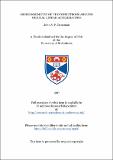Files in this item
Microdosimetry of photoneutrons around medical linear accelerators.
Item metadata
| dc.contributor.advisor | Watt, D. E. | |
| dc.contributor.author | Crossman, John S. P. | |
| dc.coverage.spatial | 186 p. | en_US |
| dc.date.accessioned | 2018-05-17T10:11:02Z | |
| dc.date.available | 2018-05-17T10:11:02Z | |
| dc.date.issued | 1997-06 | |
| dc.identifier.uri | https://hdl.handle.net/10023/13366 | |
| dc.description.abstract | Photoneutrons produced in the vicinity of medical linear accelerators for therapy, constitute a hazard which is difficult to assess and monitor. The aims of the project were to develop new techniques, using microdosimetry, which would be suitable for the improved quality control of pulsed photon beams and for the assessment of the associated photoneutron hazard in typical treatment facilities from the perspective of the patients and staff. The measurements of photoneutron yields and equivalent doses were obtained using activation analysis detectors around a 10 MV LINAC. To obtain adequate statistical precision, an optimum thickness of 2.5 cm of polyethylene was used that doubled the detector's sensitivity. This enabled the yields and spatial distribution of the low intensity field to be recorded. Photoneutron equivalent dose-rates of up to 0.104 Sv.h-1, or 0.1% of the useful photon dose- rates, were measured. In the literature, however, it was found that equivalent dose-rates could reach as high as 1 % of the useful photon treatment dose-rate for machines operating at X ray energies of ≥18 MV. Thus it is recommended that to uphold the principle of ALARA, such high energies (≥18 MV) should only be used when no lower energy machine is available. Microdosimetry with a tissue equivalent proportional counter (TEPC) microdosimeter, enabled the photoneutron contribution to the quality spectrum to be identified in the maze to the treatment room of the 10 MV LIN AC, and the photoneutrons there were assigned a radiation weighting factor of 20. The known problems concerning the rf interference and very high pulsed dose-rates inside the treatment room proved too severe to obtain meaningful results with the TEPC. The microdosimeter did however provide useful diagnostic information. Furthermore, a novel calibration technique for TEPC's was developed and an established one, the proton-edge method, was improved. A new approach was adopted to conduct microdosimetry in the vicinity of medical accelerators. This involved the design of a condensed phase microdosimeter comprising, a miniature CsI(T1) scintillator coupled to an optical fibre 20 m long, for conducting in-beam, on-line measurements of quality spectra. However, Cerenkov light and scintillation light produced in the optical fibre by the radiation fields was the cause of strong interference that has yet to be overcome. The application of the microdosimeter, which is still under development, to brachytherapy is proposed for in-vivo measurements. | en_US |
| dc.language.iso | en | en_US |
| dc.publisher | University of St Andrews | |
| dc.subject.lcc | RA1231.R2C8 | |
| dc.title | Microdosimetry of photoneutrons around medical linear accelerators. | en_US |
| dc.type | Thesis | en_US |
| dc.contributor.sponsor | C.E.C | en_US |
| dc.contributor.sponsor | Scottish Home and Health Department | en_US |
| dc.contributor.sponsor | Association for International Cancer Research | en_US |
| dc.type.qualificationlevel | Doctoral | en_US |
| dc.type.qualificationname | PhD Doctor of Philosophy | en_US |
| dc.publisher.institution | The University of St Andrews | en_US |
This item appears in the following Collection(s)
Items in the St Andrews Research Repository are protected by copyright, with all rights reserved, unless otherwise indicated.

